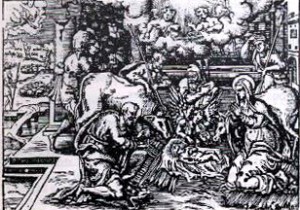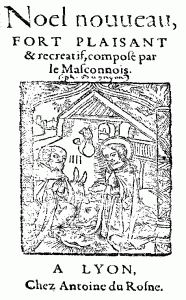The Noëls in Charpentier’s Messe de Minuit
The most distinctive feature of Charpentier’s Messe de Minuit is of course its use of the melodies of traditional French Christmas carols, or noëls. Since the fifteenth century, noëls have been sung by Frenchmen of all classes to celebrate the Christmas season. Most of the tunes that Charpentier employed in his setting of the mass ordinary were already centuries old and would have been as familiar to his listeners as Silent Night or O Come All Ye Faithful would be to audiences today. Indeed, many of the noëls used by Charpentier are still sung in Francophone countries around the world today.
The use of the word noël in reference to the birth of Christ can be traced back even further to the 13th century. The word is related to newness, as in “good news” or “New Year,” and was used in non-Christmas contexts as well. By Charpentier’s time, noël could refer to Christmas Day itself, songs related to Christmas (like those upon which his mass is based), or simply an exuberant cry of rejoicing.
The tunes themselves most often had an existence independent of their Christmas lyrics and with very few exceptions collections of noëls (typically called Bibles des Noëls) contained only the texts with an indication to sing the words to a tune (or timbre) often identified by their commonly known secular titles. Not until Christophe Ballard’s Chant des Noëls, published in Paris in 1704, do we find a complete collection of noëls with words and music – in this case as continuo songs or airs.
The noel tunes are noted for their simplicity, their often dance-like rhythm and above all the bucolic nature of their texts. Most concern themselves with the response of the shepherd’s and townspeople after receiving the news of Christ’s birth from the angel and their subsequent celebration and rejoicing as they hurry off to the manger. The characters in the noëls are distinctly French and the lyrics include frequent references to food and wine – some things never change! By the end of the 17th century, many French composers had embraced these rustic tunes and settings for organ and various instrumental ensembles were published from the 1680s onward. Charpentier’s use of the tunes in a “parody” technique in his mass was most likely the first, though several others followed.
The timbres of many of these noëls have appeared in other Magnificat productions, notably in the two opera parodies we produced in 1996 and 1998. Here of course any association with Christmas was absent – they were just universally familiar tunes to which, in those cases, very silly texts were sung. We have also programmed noëls as part of Christmas programs in 1993, 1996, 2002 and 2005. Here is a live recording of the noël Où s’en vont ces gais bergers that includes Charpentier’s instrumental arrangement from a Magnificat performance in December 2005. This noel tune appears in the Gloria of the Messe de Minuit.
[audio: http://magnificatbaroque.com/audio/Noel__Ou_sen_vont_ces_gais_bergers.mp3]Charpentier uses each of the ten melodies as the basis for a defined section of the Mass, for example, Joseph est bien Marie serves as the subject matter of the first Kyrie, Or, nous dites Marie for the Christe and Une jeune pucelle (familiar to modern audience from its use in the 1991 film Tous les Matins de Monde) for the second Kyrie. In addition to the ten noëls that Charpentier uses in the mass ordinary, he also suggests that after the Credo, an instrumental setting of “Laissez paistre vos bestes” be performed at the Offertory – and he provides just such a setting elsewhere in his notebooks.
Charpentier’s use of the noel tunes fits well with the Jesuit approach of ‘enculturation,’ the blending of indigenous cultural traditions in the service of God and the celebration of the sacraments. It is especially fitting that these popular noëls were incorporated into a mass explicitly intended for Christmas Eve – precisely on this unique night when God takes on human form, when the sacred can combine with the secular.


Really nice piece! Charpentier’s Messe de Minuit may be the first piece of French baroque music I ever heard–I never tire of it.